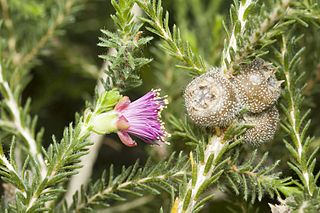
Calothamnus chrysanthereus , commonly known as claw flower is a plant in the myrtle family, Myrtaceae and is endemic to the south-west of Western Australia. It is an erect shrub with needle-shaped leaves crowded on the ends of the branches and bright red flowers in spring.

Calothamnus gilesii is a plant in the myrtle family, Myrtaceae and is endemic to the south-west of Western Australia. It is an erect, usually compact shrub with fine, pine-like foliage and which produces cluster of red flowers from June to January.

Melaleuca leiocarpa, commonly known as pungent honey-myrtle, is a plant in the myrtle family, Myrtaceae and is native to arid areas in parts of South Australia and Western Australia. It is an erect or branching shrub distinguished by its prickly foliage, yellowish flowers and, for a melaleuca, unusually large, smooth, roughly spherical fruits.

Melaleuca bisulcata is a plant in the myrtle family, Myrtaceae and is endemic to the a relatively small area on the west coast of Western Australia. It is difficult to distinguish this species from Melaleuca psammophila except on differences in the shape of the calyx lobes.

Melaleuca cardiophylla, commonly known as tangling melaleuca or umbrella bush is a plant in the myrtle family, Myrtaceae and is endemic to the west and south-west of Western Australia. It is a dense, prickly shrub with heart-shaped leaves, stamens that are joined in unusually long claw-like bundles, and distinctive, warty fruits.

Melaleuca concreta is a plant in the myrtle family Myrtaceae and is endemic to the south-west of Western Australia. The species name (concreta) refers to the way the fruits are tightly packed together.

Melaleuca filifolia, commonly called wiry honey-myrtle, is a plant in the myrtle family Myrtaceae, and is endemic to the south-west of Western Australia. It is a woody, twiggy shrub with needle-shaped leaves, greenish flower buds, pink "pom-pom" flower heads and spherical clusters of fruits.
Calothamnus blepharospermus is a plant in the myrtle family, Myrtaceae and is endemic to the west coast of Western Australia. It is an upright, spreading, bushy shrub with red flowers in summer. It grows in sandy soil in scrubby country called kwongan.

Calothamnus longissimus is a plant in the myrtle family, Myrtaceae and is endemic to the south-west of Western Australia. It is a small, spreading shrub with unusually long, fine leaves and which produces clusters of red flowers in spring.
Calothamnus microcarpus is a plant in the myrtle family, Myrtaceae and is endemic to the south-west of Western Australia. It is an erect, either compact or spreading shrub with flat leaves and clusters of red flowers in spring.
Calothamnus oldfieldii is a plant in the myrtle family, Myrtaceae and is endemic to the south-west of Western Australia. It is a small, spreading shrub with needle-shaped leaves and clusters of red flowers with 5 petals and 5 stamen bundles.
Eremaea × codonocarpa is a plant in the myrtle family, Myrtaceae and is endemic to the south-west of Western Australia. It is thought to be a stabilised hybrid between two subspecies of Eremaea. It is a small shrub with triangular leaves and flowers a shade of pink to purple on the ends of the branches.

Eremaea ebracteata is a plant in the myrtle family, Myrtaceae and is endemic to the south-west of Western Australia. It is a shrub with narrow, mostly linear leaves and which bears orange-coloured flowers on the long branches of the same season's growth. The fruits have a surface that is rough and lumpy.

Eremaea ectadioclada is a plant in the myrtle family, Myrtaceae and is endemic to the south-west of Western Australia. It is a low, spreading shrub with small leaves, and orange-coloured flowers on the ends of the long branches which grew in the previous year.
Eremaea hadra is a plant in the myrtle family, Myrtaceae and is endemic to the south-west of Western Australia. It is a shrub with thin, flat and very prickly leaves. It has violet-coloured flowers on the ends of its branches in late spring followed by smooth, cup-shaped fruits.
Eremaea × phoenicea is a plant in the myrtle family, Myrtaceae and is endemic to the south-west of Western Australia. It is thought to be a stabilised hybrid between two subspecies of Eremaea. It is an erect to spreading shrub with pointed, elliptic leaves and small groups of flowers, a shade of pink to red, on the ends of the branches.

Eremaea purpurea is a plant in the myrtle family, Myrtaceae and is endemic to the south-west of Western Australia. It is a shrub with erect branches, small leaves and purple flowers in pairs on the ends of the branches. The fruits are woody, cup-shaped capsules which release their seeds when dry.

Eremaea violacea is a plant in the myrtle family, Myrtaceae and is endemic to the south-west of Western Australia. It is low, spreading shrub with narrow, prickly leaves and which bears violet-coloured flowers on short side branches.

Phymatocarpus maxwellii is a plant in the myrtle family, Myrtaceae and is endemic to the south-west of Western Australia. It resembles many small species of Melaleuca, mainly differing in the way its anthers are attached at the top of the stamens. In Phymatocarpus they are attached at their base and open at the other end through two slits. It is a shrub with many small heads of pink to purple flowers, often covering the plant for several weeks in October.

Phymatocarpus porphyrocephalus is a plant in the myrtle family, Myrtaceae and is endemic to the south-west of Western Australia. It resembles many small species of Melaleuca, mainly differing in the way its anthers are attached at the top of the stamens. In Phymatocarpus they are attached at their base and open at the other end through two slits. It is a shrub with many small heads of pink to purple flowers fading to white, often covering the plant for several weeks in spring.
















